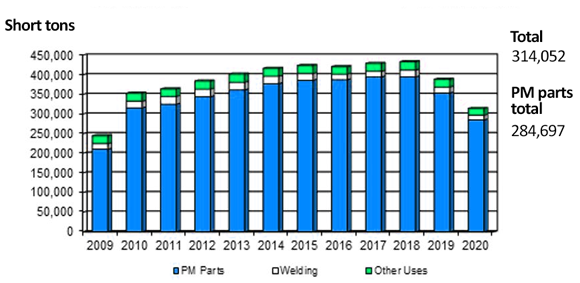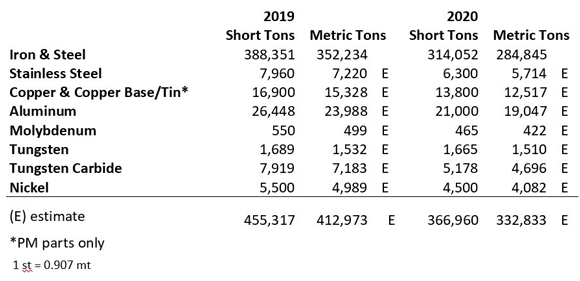PowderMet2021: State of the PM industry in North America in 2020
June 23, 2021

The International Conference on Powder Metallurgy and Particulate Materials (PowderMet2021) was held in Orlando, Florida, USA, from June 20–23, 2021. Organised by the Metal Powder Industries Federation (MPIF), this year the event welcomed both onsite and online participants in a hybrid format due to the ongoing global COVID-19 pandemic.
The MPIF’s president, Dean Howard, began the event with a presentation reporting on the state of the North American Powder Metallurgy industry which, as a result of the pandemic, has endured one of the worst periods of declining production and sales in its history.
“However, the PM industry is a resilient consolidation of many forces, which found its inner strength to rally, and became stronger as a result of these turbulent times,” stated Howard. “I am unaware of a single North American PM company that permanently closed its operations as a direct result of the pandemic. Many companies’ representatives report that their organisations are working mandatory overtime due to shortages of skilled workers and engineers, while setting new production levels because of pandemic induced solutions. We are all survivors, and the PM industry is still alive and well, landing back on its feet, well on its way to recovery.”
Metal powder shipments
Metal powder shipments fell drastically in April and May 2020, but started recovering in June. When the final numbers were tallied, the total North American metal powder shipments declined by an estimated 19% to 332,833 mt (366,960 st).

Total iron powder shipments decreased 19.1% to 284,845 mt (314,052 st). PM and friction-grade powder shipments were down 19.4% to 258,220 mt (284,697 st). Welding applications dropped by 20% to 10,993 mt (12,120 st). Cutting, scarfing, and lancing applications declined by 21.9% to 679 mt (749 st). Miscellaneous uses declined 13.9% to 14,953 mt (16,486 st).
Stainless steel, copper, nickel, and aluminium powder shipments all declined by an estimated 18 to 21%. Estimated shipments for 2020 include: stainless steel powder, 5,714 mt (6,300 st); copper and copper base powder, 12,517 mt (13,800 st); nickel powder, 4,082 mt (4,500 st); and aluminium powder 19,047 mt (21,000 st).
Molybdenum shipments declined an estimated 15.4% to 422 mt (465 st). Tungsten powder shipments decreased by an estimated 1.4% to 1,510 mt (1,665 st), and tungsten carbide powder shipments decreased an estimated 34.6% to 4,696 mt (5,178 st).
Conventional Press & Sinter
The demands for products containing conventional Press & Sinter PM surged during the second half of 2020 and has continued to move in a positive direction since, stated Howard. Disrupted supply chains resulted in the re-shoring of some PM parts.
Historically, the North American iron powder shipments mirrored the automotive industry, with over 70% of the iron powder shipped used for parts in internal combustion engine (ICE) automobiles and light trucks. “As you can imagine, the alarm has been sounded regarding the move to alternative fuel systems and subsequent elimination of ICE,” Howard added.
In 2020, light truck production hit a record high of almost 80% of all vehicles produced in North America, representing good news for the PM industry as light trucks (pickup/large SUV) account for an estimated average of 27.2 kg (60 lb) of PM per vehicle, followed by mid-size/crossover at 18.1 kg (40 lb), and sedans at 9.1 kg (20 lb). HV and EV are difficult to estimate, stated Howard, with EV estimates ranging from 1.8-3.6 kg (4-8 lb) of PM.
Metal Injection Moulding and metal Additive Manufacturing
While general manufacturing was down in 2020, Metal Injection Moulding (MIM) and metal Additive Manufacturing performed much better, Howard further added. Domestic and globally produced MIM and AM fine powders (less than 20 micrometres) consumed in North America increased an estimated 3-5% to 3,741-3,809 mt (4,125-4,200 st). Low alloy and stainless steel made up the bulk of the powders consumed.
“It is safe to say that the partition between MIM and AM processes is disappearing. At least a dozen MIM companies have added in-house AM capabilities or are collaborating with others, bringing parts to market quicker, using the same powders, without the need for tooling. When quantity levels justify, the parts can be moved to MIM,” noted Howard.
Refractory metals
The refractory metals market in 2020 was down significantly for both North American powder shipments and imports. Compared to 2019, North American shipments of tungsten carbide powders in 2020 were down an estimated 34.6%, with imports of tungsten carbide powders down by 41%.
The tungsten market was estimated slightly down overall, but strong growth in the semiconductor chip industry drove demand for high purity tungsten powder. Additionally, tungsten powder required for defence remained strong. Traditional uses for tungsten powders were significantly depressed.
The tungsten carbide markets continued to fall in 2020 due to the devastated oil and gas market, decreased US and global coal mining, and a drop in demand for tungsten carbide cutting tools due to a reduction in manufacturing. Aerospace and automotive had a real impact in reducing the demand for cutting tools; the immediate drop in demand from the aerospace sector led to order cancellations and production stoppages.
Powder Metallurgy outlook
“The writing is on the wall. Whether we like it or not, the automotive industry will change due to ambitious efforts to curb the production of ICE-propelled vehicles by 2035, and the trickledown effect will affect the entire PM industry. I believe the industry will be able to adapt and overcome, but we will need the mindset and resources to adjust to the changing environment,” warned Howard.
“The future is bright for the PM industry, but we need to be looking years down the road – even decades, rather than months. Now is the time to identify who we are as an industry. We need to invest in research and development to create new applications using metal powders and PM parts, and showcase the attributes of this exciting technology.”














